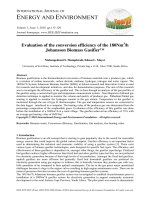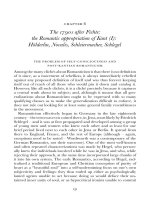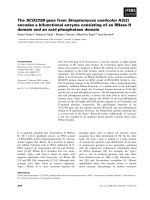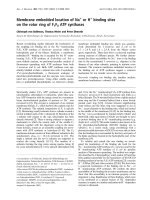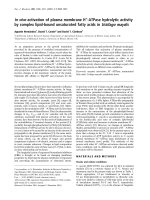Feeding rate responses of babylonia formosae h
Bạn đang xem bản rút gọn của tài liệu. Xem và tải ngay bản đầy đủ của tài liệu tại đây (537.08 KB, 5 trang )
onlinelibrary.wiley.com
Feeding rate responses of Babylonia
formosae habei (Prosobranchia: Buccinidae)
larvae on cultured algae - Chen - 2017 Aquaculture Research
Yan Chen
5-6 phút
Original Article
Feeding rate responses of Babylonia formosae habei
(Prosobranchia: Buccinidae) larvae on cultured algae
Corresponding Author
E-mail address:
College of Marine Sciences, Shanghai Ocean University, Shanghai, China
Key Laboratory of Sustainable Exploitation of Oceanic Fisheries Resources (Shanghai Ocean
University), Ministry of Education, Shanghai, China
Correspondence: Y Chen, College of Marine Sciences, Shanghai Ocean University, Shanghai
201306, China and C‐h Ke, College of Ocean and Earth Sciences, Xiamen University, Xiamen
361005, China. E‐mails:
;
Search for more papers by this author
Cai‐huan Ke
Corresponding Author
E-mail address:
College of Ocean and Earth Sciences, Xiamen University, Xiamen, China
State Key Laboratory of Marine Environmental Science, Xiamen University, Xiamen, China
Correspondence: Y Chen, College of Marine Sciences, Shanghai Ocean University, Shanghai
201306, China and C‐h Ke, College of Ocean and Earth Sciences, Xiamen University, Xiamen
361005, China. E‐mails:
;
Search for more papers by this author
Xiao‐jie Dai
College of Marine Sciences, Shanghai Ocean University, Shanghai, China
Key Laboratory of Sustainable Exploitation of Oceanic Fisheries Resources (Shanghai Ocean
University), Ministry of Education, Shanghai, China
Search for more papers by this author
First published: 01 April 2016
Cited by: 1
Get access to the full version of this article.View access options below.
Log in with Open Athens, Shibboleth, or your institutional credentials.
If you have previously obtained access with your personal account, Please log in.
Abstract
Babylonia formosae habei is a commercially important marine gastropod species. Food particles
ingested by the planktotrophic larvae of B. formosae habei can be critical in maximizing the
larval growth and survival of this species. In this study, feeding rate responses of B. formosae
habei larvae on cultured algae were observed using a Coulter multisizer. Variations were
recorded based on the changes of different factors of influence, including varied larval stoking
density, varied types of algae, varied algae concentrations and selective feeding on mixed algae
cells of different types. Results of this study reveal some facts on the feeding of B. formosae
habei larvae: larval stoking density has negative effect on their feeding rates; larva has a higher
feeding rate on big‐sized algae than small‐sized algae; larva has a higher feeding rate on diatom
than green algae and flagellate; feeding rate of larvae increased when fed mixed algae
cells. Optimal algal concentration of the cultured algae Chlorella sp., Chaetoceros muelleri,
Isochrysis zhanjiangensis and Dunaliella tertiolecta was suggested at 20 × 104, 5 × 104, 20 × 104
and 10 × 104 cells mL−1 respectively. Results of the preset study can be important in
understanding feeding ecology of B. formosae habei larvae, and applicable for the aquaculture of
this species.
Related
Information
Downloads: 22
Citations: 1
© 2016 John Wiley & Sons Ltd
o
o
o
o
o
o
o
o
o
o
Babylonia formosae habei
larva
feeding rate
algae
Coulter multisizer
Earmarked Fund for Modern Agro‐industry Technology Research System. Grant
Number: CARS‐48
Major Program of the National Natural Science Foundation of China. Grant
Number: 41176110
China Scholarship Council
Issue Online: 10 March 2017
Version of Record online: 01 April 2016

